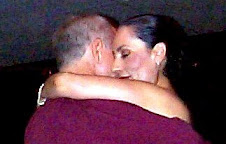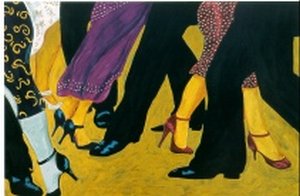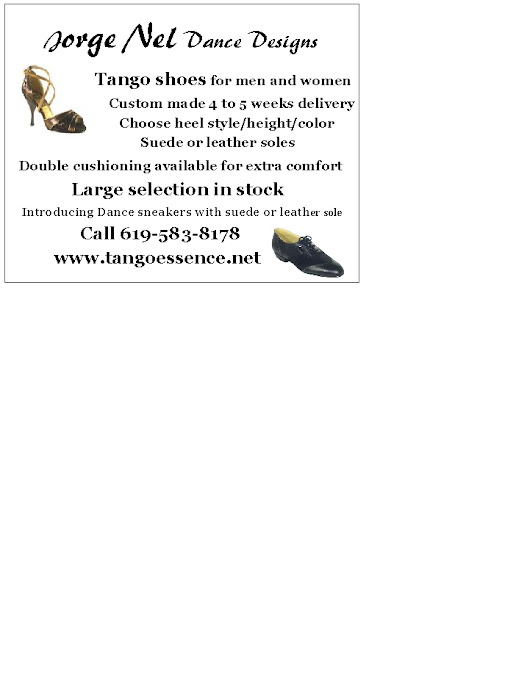Interview with Korey Ireland
November 2004: Based in Kansas City, Korey is a composer and musician who regularly travels to tango festivals around the country and comes through New York City every so often. We asked him to answer a number of questions about tango dancing from a musicians point of view.
Close-Embrace.com: What is tango? How do you know if a piece of music is tango or not?
Korey Ireland: This is really subjective. What someone in Finland calls tango, would differ from what someone in Argentina calls tango and further from what someone in San Francisco might call tango. My version...well we could describe the musical skeleton: the rhythmic framework and relation of phrases, the form, and arrangement techniques that characterize the music we're familiar with as tango dancers, we could get really precise with this, but what we end up with is a very detailed skeleton, and it would still require some technical expertise to differentiate Di Sarli's musical skeleton, from, say Cole Porter's. To the untrained eye, they both just look like skeletons. But there is an emotional quality, an energy that we immediately recognize as tango, to extend the metaphor, perhaps we look to the skin, the features, the face or the music (the sounds, the way the lines are articulated, the phrasing) and I think we get a slightly more satisfying description. This might even help us to recognize a tango that is dressed up in different clothing (perhaps with saxophones, synthesizers, or percussion tracks) that conform to the style of a given time or place.
But ultimately, for me, all of these descriptions or identifiers fall a little short. Its not the skeletal structure, the surface attributes, or the fashion that determines ultimately if a song feels like tango, its the soul of the music. Its the underlying expression, not the means of expressing. For me, this was most clear in the early morning hours at Bar Roberto in Buenos Aires, where well-lubricated patrons had enjoyed hours of tango music with a rotation of singers and musicians, finally around 6am the musicians called it a night, but the patrons, kept it going, taking turns singing their favorite songs with more fervor then musical skill and being genuinely and unreservedly moved by the words and the melodies. This, for me, is the soul of tango, the feeling that draws tears to your beer mug as the morning light creeps under the door. Its an expression that is ultimately more human than musical.
Close-Embrace.com: What rhythm should you dance to in a tango if there's more than one?
Korey Ireland: You should do the one that your teacher asks you to do :-) Seriously, tango is about expression, hopefully what you are inspired to express will help you decide which element in the music to embrace. I often relate to the bass line to move my partner's feet, and the strings and bandoneons perhaps to influence my torso and embrace. But it changes all the time, just as the music constantly shifts. For me, this falls in the category of things better felt then understood. Our analytical minds are rather blunt instruments for creating expressive tangos, but our bodies, hearts, souls can find this fairly naturally, after all, that's pretty much where it comes from.
Close-Embrace.com: Is there such a thing as dancing the melody as opposed to dancing the rhythm?
Korey Ireland: I suppose. Although, from a musician's stand point its a little bit awkward to separate the two. Melody contains an element of rhythm. So when we dance the melody, I think what we're actually doing is allowing the melodic shape to influence which rhythms we move to. It is difficult to literally articulate some melodies. Imagine trying to step on every melodic note of Reliquias Portenas for example. It would be something akin to an epileptic seizure. But we could let melody suggest places to add little rhythmic moments and perhaps places to use less activity. I think often, good dancers use the melody to keep the dance from becoming routine. Melodies often share very human characteristics, like the need to breath, or to balance tension and release. This can be a great influence on the dance.
Close-Embrace.com: Are you dancing if you are not on the beat?
Korey Ireland: Quite possibly. I think its also possible to move absolutely on the beat without dancing. Sometimes we mistake marching for dancing. The first expresses time and direction, the second expresses the things we don't have words for.
Close-Embrace.com: What's the difference between syncopa and quick, quick, slow?
Korey Ireland: Let's say that quick, quick, slow is even division of the time, its part of a rhythmic texture that tango musicians would call the marcacto. This would be something like ONE, two, THREE, four, where 1 and 3 are stressed and 2 and 4 are pretty light. Sorta like saying Oom-pah, Oom-pah. We normally dance '1..3..1..3..' The quick, quick, slow rhythm in this context could mark '1.2.3..' or '3.4.1..'
Syncopa refers to an asymetrical division of time. This is easier to hear then to see in text, but we could demonstrate in a couple ways. Because syncopas split the strong pulse in an uneven way we need to divide the beat further. Instead of have 4 slices of tango pie, we'll have 8, but the pie is the same size, just smaller slices. For text, we'll say that in between each numbered slice (1.2.3.4) is a slice called "and" or "+". So we could count all the slices: '1.+.2.+.3.+.4.+.' We get the sound of the syncopa by leaving out beats (numbered slices of time) and emphasizing the subdivision between beats (the '+' slices). A very common syncopa would be '1.+...3', with some orchestras we hear '1.+..+.3.' The even or symmetrical division between the strong beat 1, and the next strong beat 3, would be 2. But the syncopa evades this beat to give more excitement. It feels a bit bouncy, or even perhaps jazzy.
Why is Piazolla's music difficult to dance to?
Korey Ireland: Because we're not accustomed to dancing to it. Because its often not written with the intention of accompanying social dancers. Because it is dynamic, and often follows a different energetic/dramatic trajectory than the classic dance music that we're used to. Tango dance is full of convention, and those conventions grew up side by side with the music culminating in the 40's. From there, we find a bit of parting of the ways between tango music, and tango social dance. So our conventions are not built for the dynamism and rhythmic palette of Piazzolla. Now, granted, I'm generalizing, there some Piazzolla that's quite traditional and palatable to dancers accustomed to Golden Era music. But we need a slightly different tool kit to dance to Libertango, or Milonga Angel. In particular, rhythm and that trusty marcato that gives us the ubiquitous quick, quick, slow plays a different role in Piazzolla. Often an exaggerated role. The good news is, that we grow by dancing to this sort of music, we expend our expressive palette and then we have more to offer to the music which is already familiar.
Close-Embrace.com: What about Salgan's music?
Korey Ireland: I find Salgan very exciting to dance to. He is sort of a bridge between the conventions of the 40's and the experimentation of the 50's and 60's. He records lots of classic tunes in very fresh and innovative arrangements and brings a fabulous rhythmic sense. Salgan expands and develops the role of syncopa, he makes it an equal partner with the marcato rhythm, and invites us as dancers to find a similar versatility in our quick, quick, slow mentality. I find many of the dynamic movements which are so popular with social dancers right now (wraps, hooks, spins, off axis moves) work very naturally in this energized rhythmic sensibility. I think it gets confusing for dancers at times because the strong beat that we're accustomed to anchoring to is often de-emphasized or even left out. But, the music doesn't abandon us. If you listen, Salgan kinda leads you along, as if with a trail of bread crumbs from one little moment to the next. I think it requires fresh ears, especially since many of the pieces he recorded are already familiar to us in other versions. Think of it like the dilemma of the intermediate follower who has been led through same steps enough that she starts to anticipate the resolution of the movement and is startled or unavailable when her expectation isn't fulfilled. With our followers, we consider this part of the learning process and encourage them to be open to experiencing a new possibility, to keep open, to keep listening. Why should it be any different with our expectations in the music?
Close-Embrace.com: What about Gobbi's music?
Korey Ireland: I'm not sure why one would find Gobbi difficult to dance to, or at least any more so then Pugliese. Gobbi of the mid-late 50's is a bit more dramatic and exaggerated then I'm personally attracted to, but the techniques, the devices are all the same as his predecessors. Just a little more fluid with tempo, tending to push a bit in marcato sections, and drag a bit in legato (smooth, without separation) phrases. Perhaps to a dancers who sets his clock at the beginning of the song and stops listening, this could be disconcerting. I've heard claims that good dance music shouldn't change tempo; I don't agree. Good marching music shouldn't change tempo, good dance music should make us want to dance, to express. Ultimately, I think it has a lot to do with familiarity. Gobbi does a lot of the same tempo tricks as Pugliese, just with a different sensibility. I think we often relate more easily to Pugliese just because we hear it more often.
Close-Embrace.com: If you like dancing to those orchestras does that mean you don't enjoy orchestras like D'Arienzo as much?
Korey Ireland: Absolutely not. In fact, as I suggested earlier, I think learning to dance to some of this expanded rhythmic vocabulary actually helps a lot when you return to D'Arienzo. We still have syncopas and little rhythmic games in D'Arienzo, and if we've become accustomed to the prominence those devices play in the music of Salgan or Piazzolla, I think we have even more to offer to D'Arienzo.
Close-Embrace.com: What do you think of D'Arienzo?
Korey Ireland: I think it's great dance music. Its hard to imagine a really fulfilling night of dancing without any D'Arienzo. At the same time, I wouldn't want to spend my whole tango life in that one flavor...
Close-Embrace.com: Is it important to try to dance to difficult music or non-tango music?
Korey Ireland: Important? I suppose that depends on your goals. I think it can be very enjoyable, and it can improve your dancing, if these things are important then I suppose the answer is yes.
Close-Embrace.com: Is tango music dead, dying, surviving or growing?
Korey Ireland: Tango as music has continued to evolve and develop, but it's done so separately from tango as dance. I look forward to a happy reunion, and I see signs of it. There are challenges, economic, attitudinal, logistical, but I'm especially encouraged to see more and more dancers becoming actively involved in creating tango music, and even some musicians becoming interested in the dance. This bodes well for all of us. I don't have numbers at hand, but my perception is, the number of tango CDs released in the last year is probably triple the number released in the year 2000. I find that very encouraging. Even better, in this country, the number of tango bands that perform for dancers at least once a month, has probably increased five fold in that same time period. We're still a ways away from that happy reunion, but I think we're moving in that direction.
Close-Embrace.com: What's the most interesting thing going on in tango today?
Korey Ireland: For me, it's this gypsy community of festival goers. This is novel phenomenon in the history of tango, and I think its influence could prove to be pretty remarkable. We develop in our own communities and then collide few times a year with a strong influence on each other and a sense of shared purpose. I'd like to see some of this happen with the music as well. I think it will.




